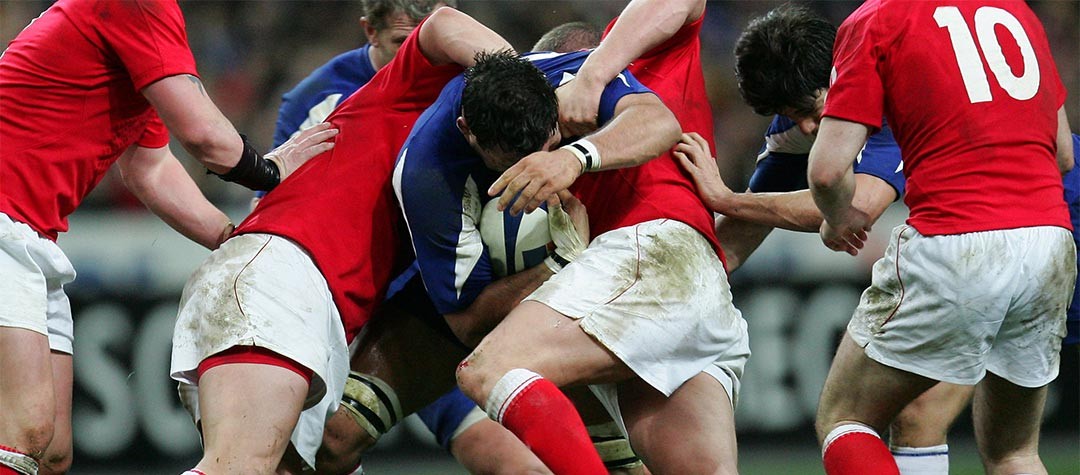
A rugby scrum plays an important role in the game. This allows players to collide at high speeds and push their opponents into one another. A rugby scrum can be very dangerous. The old style of scrums was eventually banned because they were too violent and put too much strain on the forwards. These scrums are now regulated by rules set forth by the Rugby Union.
The sustained push phase of a Rugby scrum involves biomechanical demands.
For rugby players, the sustained push phase in a scrum is a demanding biomechanical task. This phase requires players to exert force from many positions. Specifically, the force exerted by an individual player varies depending on their stance and body positioning, but the force exerted by a pack of players should be greater than the sum of these individual contributions.
A systematic literature review was conducted to examine the biomechanical demands of this phase of the scrum. Pubmed, EBSCO Academic Search Premier, CINAHL, SPORTDiscus, and Google Scholar were searched for articles that reported the force produced during simulated rugby scrums. The data were extracted using a narrative-synthesis method from the retrieved articles.

Effects of playing level on rugby scrum force
While there isn't a clear correlation between playing level and the rugby scrum force produced, some evidence suggests that the number forwards in a pack can influence the force they produce. Live scrums show that winning packs can produce as much as 1081 N more force than their losing counterparts, and up to twelve times the force if they are normalized for their combined weight. In order to gain possession, winning packs will tend to push their opponent pack about 1.5 meters behind.
The strongest differences are found in the maximum force produced during the sustained pushing phase, and these differences are most obvious in elite and professional packs. The difference in absolute force is particularly large, which could be due to the higher mass of these packs. However, the difference in standard deviations is smaller, indicating less variability. The maximum force generated also decreases with increasing pack mass and playing level.
Rugby scrum rules changed
The history of rugby scrums has changed significantly over the years. They are no longer medieval battles in which opposing hookers fought for the ball, but they have evolved to be more professional. Although the scrum is an important part the game, the rules have been updated to decrease injury risk to players. Although the scrum will be called by a referee, possession may now be changed at the referee’s option. The law of engagement has also changed to prevent dangerous contact between front rows. To prevent contact between front rows, the distance must be less that one arm's width.
There are also a number of changes to the rules for the scrum, including a maximum length of 1.5 meters for a scrum push. This rule will be applicable to both uncontested and contested scrums. This will help increase the time the ball is still in play.

An analysis of data from a systematic literature study on rugby scrum
The scrum is the most popular performance indicator in rugby league, with most articles published between 2005 & 2010. The period 2003 to 2007 was the most frequent time period that was investigated. The 2006 season was the most studied, followed by the Super Rugby Championship.
Injury incidence was higher among forwards than backs, with a greater percentage of players out of the game for two or more days. More than half were injuries sustained while running and tackling.
FAQ
Why do people enjoy extreme sports?
There are several reasons why people enjoy extreme sports.
They offer thrills.
Second, extreme sport is exciting. They tend to be unpredictable and sometimes scary.
They give people the chance to push their boundaries. You never know what will happen next!
Fourth, they can be used to help people escape everyday life.
Fifth, they allow people freedom to express their feelings through creative forms of art. Extreme sports include surf carving, which is an artistic expression.
Sixth, they help people remain fit. Extreme sports can be beneficial for your body. Skydiving helps with coordination, balance, as well strength.
Extreme sports can be fun. Being part of a team is a lot of fun, especially if everyone is having a great experience.
What makes a sport extreme?
Since ancient times, sports are a part of our daily lives. They've evolved to be more than just competitions for athletes. Some sports have become part our culture.
Extreme sports may be due to the intense competition. Pro basketball players, for example, play against one another almost every day for many hours. Other sports are considered extreme because they require special equipment. Snowboarding, for example, involves riding down hills on two-wheeled boards attached to the bottom.
Other sports are considered extreme because the rules are different from other sports. For example, soccer can be played in a different way than American football.
Some sports are considered extreme because their participants are required to perform feats of athleticism. For example, gymnastics can be extremely difficult because the athletes must balance themselves on various objects without falling off.
What companies are most likely not to sponsor extreme sport?
Sponsoring extreme sports events like BMX, skateboarding and snowboard competitions is a common practice for large corporations with large advertising budgets. They also tend to be very active within the community in which they operate. Coca-Cola sponsors many local sports events and other activities all across North America. Coca-Cola also sponsors camps and youth programs at both the local and national levels. In addition, Coke sponsors the annual "Coca-Cola Rock 'N' Roll Marathon" in New York City. The event attracts around 100,000 runners from all parts of the globe.
Is extreme sport dangerous?
Extreme sports present dangers because they expose people to serious injury and death. There have been many deaths due to other causes such as drowning, electrocution and car accidents.
Even when you are doing something extremely safe like riding a bicycle or rollerblading, injuries can still happen.
Some people avoid extreme sports because they fear injury.
The National Football League forbids players from participating in extreme sports like skateboarding because of the high risk involved.
You should be careful about what you do and how others react to your extreme sport endeavors.
What is the difference between extreme sports and regular sports?
Extreme sport requires physical exertion or skill in combination with a challenge.
It could also include equipment such as goggles, helmets, or special clothing.
Extreme sports aren't like traditional sports. You don't need to be trained to participate.
They are typically outdoors and don't offer any safety net in the case of an accident.
Some extreme sports may be illegal while others are legal. It all depends on where and what type activities you're involved.
Check the local laws before undertaking extreme sports.
What's the most dangerous extreme sport?
It is snowboarding as you balance on top and then fall down from high altitudes. If you fall in the wrong direction, it could lead to your death.
What skills is required to participate in extreme sports
To become proficient in any extreme sport, you must practice every day.
You should practice new moves and techniques. This will help improve your performance.
You should also be familiarized with safety rules before you attempt anything new.
For example, helmets should always be worn. It is important to keep your eyes on others.
A spotter is essential for any stunt. During your stunt, you will need a spotter to keep an eye on you.
Statistics
- Nearly 40% of all mountain bikers have at least graduated from college. (momsteam.com)
- Based on the degree of difficulty, the routine is scored on form and technique (50 percent), takeoff and height (20 percent), and landing (30 percent). (britannica.com)
- According to the United States Parachuting Association, about 21 people die yearly from skydiving. (livehealthy.chron.com)
- Since 1998, overall participation has grown nearly 25% - from 5.2 million in 1998 to 6.5 million in 2004. (momsteam.com)
- Nearly 98% of all "frequent" roller hockey participants (those who play 25+ days/year) are male. (momsteam.com)
External Links
How To
How do I learn to snowboard for beginners?
This section will cover how to get started in snowboarding. Everything from where to go to purchase equipment, how to learn and what to do, will be covered.
Let's start by defining some basics.
"Snowboard": A board that is attached to your feet for skiing down hills. The board's shape is usually made up of two edges, the front and back. The board's front edge is larger than its back edge in order to control speed.
"Skier", a person who is skilled at riding a ski/snowboard down hills. Skiers are known to wear "boots", "pants," "helmets," and "boots". Helmets protect their heads when they fall.
Skiing - A sport that involves riding down hills on skis. This can be done on either natural terrains (such as mountains) or man-made surfaces like ski resorts. Skiing requires special equipment such as skis and poles, bindings or boots, gloves, goggles, sunglasses and socks.
"Riding down Hills" - You must learn how you can stop yourself falling before you can ride downhill. You do this by pushing your legs against the ground, pulling your back leg upwards and kicking your front foot forward. Keep doing this until your speed is reached. You must keep your legs straight and pull them up as fast as you can. Once you have reached your desired speed, let your legs relax and allow them to come together. When you want to slow down, you just repeat the process.
Once you know how to stop yourself from crashing into the ground, you must find out how fast you want to go. There are different ways to measure speed. Some prefer to measure speed by counting laps around a mountain while others prefer to measure the distance between turns. If you want to practice controlling your speed, try measuring your speed by timing yourself or by counting laps. Practice makes perfect!
Once you have mastered the art of slowing down and speeding things up, it's time for you to master how to turn. To turn, you just need to lean your body towards the direction you want. Lean too far, and you will crash into the ground. If you don't lean enough, you will not be able turn. Once you have mastered the basics of turning, you will be able learn tricks. Tricks are fancy moves you perform on the slopes. They require timing and balance. They can include spins, flips, and cartwheels.
There are many types. Some tricks include jumping over obstacles while others involve flipping objects over and spinning around obstacles. Each trick has its own requirements. You may have to spin 180 degrees while you jump, or you might need help landing the other side.
There are also different kinds of tricks. For example, some tricks require precision and accuracy, tricks that require strength, tricks that require agility, and tricks that require finesse.
Tricks are difficult to master. However, once you have mastered them, you will be able to perform them anywhere and anytime. While skiing is often considered to be a sport for adults only, kids love to play on the slopes. It's great to see kids perform amazing tricks, such as flipping over obstacles and sliding down hills.